Lancaster Country Club
Pennsylvania, USA
Green Keeper: Todd Bidlespacher
Please note: Lancaster Country Club owns 430 acres upon which are found the Old Course, the Highlands Nine, The Sunset Six course, tennis, pool facilities and a fair amount of unused land. This profile is strictly contained to the Old Course.
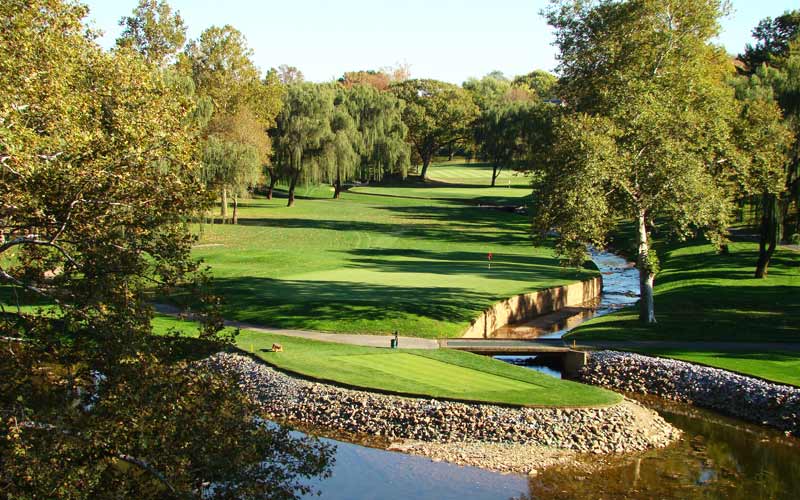
Complete with a river, its tributary, frequent elevation changes of thirty plus feet, and fertile soil,a young William Flynn was given one his best palates with which to work at Lancaster. Over a period of twenty-six years, he made the most of the opportunity.
What differentiates one inland course from another? Clearly, the answer is twofold. First, there is the property and its defining characteristics such as soil, topography, and natural hazards. Second, there is the golf course architect’s work layered upon the naked property. How did he elect to incorporate the various landforms and natural hazards into the holes themselves? How do the holes connect and what variety of challenges is asked of the golfer?
Thus, all courses are not created equal. Courses built on land blessed with an abundance of natural features have – literally – a natural advantage over courses built on less feature rich properties. In addition, certain architects are more skilled in how they interact with nature than others.
One of the best marriages of a property with a master golf course architect occurred in the rolling hills outside of Lancaster in the Pennsylvania Dutch countryside in 1919. Indeed, this was a long term marriage as architect William Flynn returned annually to the course until his death in 1945. Over this sustained period, the club led by Green Committee Chairman Roy Eshelman and William Flynn worked closely together to pull and tease the best aspects out of the property. However, understanding the progression of the course’s design is not but so easy. As Wayne Morrison, the leading authority on William Flynn, says, ‘Lancaster is far and away the most complicated architectural evolution of all of William Flynn‘s courses. Routing progressions changed and hole designs changed, some as many as seven times. Furthermore, some holes were abandoned while still others were incorporated on different parts of the club’s vast property.’
Initially, a golf professional laid out nine holes on the clubhouse side of the Conestoga River in 1913. According to Jim Finegan, the golf pro was John Reid, who is also credited as the initial designer of Huntingdon Valley, Atlantic City, Riverton and Philmont South. After the horrors of World War I concluded, the club desired to improve the nine and expand it to eighteen holes. William Flynn, who had gained famed as the Green Keeper of the West and then the East Course at Merion Golf Club, had started devoting his energies to a career as golf course architect. He was brought in but times were tough and the relationship didn’t start out smoothly. In fact, as found in the well done club history book by John B. Eshelman (Roy’s nephew) and William Mehler, Roy Eshelman once noted, ‘Unfortunately, William Flynn didn’t have the best opportunity to show his skill in building the new nine holes. We didn’t have the money to carry out his plans as laid out and furthermore, we didn’t have too much confidence in a golf architect. We took the attitude that a farmer would take toward a city boy telling him how to farm. We did pay a price later as we learned more about what constituted a good golf course.’
From this inauspicious start, Lancaster evolved into one of William Flynn‘s most heralded designs. Unlike his other high quality designs in the greater Philadelphia area, this one enjoyed national exposure in Golf Digest’s golf course rankings for two plus decades. In addition, Tom Doak shined the spotlight upon Lancaster by including it in his Gourmet’s Choice of thirty-one courses when he published his leather bound book critiquing golf courses around the world in 1994. When asked by Jim Nagle why he included it, Doak responded along the lines that the course possesses all the design features that made William Flynn such a great architect.
One such feature that the course embodies that William Flynn would later espouse is the concept of limited run with one’s tee ball. Though a staunch supporter of firm and fast conditions around the greens, William Flynn increasingly throughout his career became concerned that technology was making courses play too short. For instance, he threw out for discussion the notion of watering landing areas off the tee just enough so that the tee ball a) wouldn’t pick up dirt but b) not bound too far forward. He wanted golfers to have plenty of long approach shots as a way of testing their full repertoire.
As this relates to Lancaster, nearly half of Lancaster‘s fourteen tee shots hit into upslopes that range from slight (e.g. the ninth and sixteenth fairways) to abrupt (e.g. the third and eighteenth fairways). Other times, he used side slopes (e.g. the second and fifteenth) in the fairway to send uncontrolled tee balls into less than desirable places. According to Morrison, ‘On championship designs in particular, William Flynn required specific shot tests. He wasn’t concerned with optional ways to play a hole but rather he wanted to reveal the best strategist (mental) and the best executor of the strategy (physical). Essentially, he wanted to pose the complete test. With canted fairways, William Flynn asked the golfer to shape shots to hold the fairway and gain the correct approach angle. With reverse doglegs, he asked the golfer to realize that the long way home may be best.’
Ironically, today’s highly regarded course didn’t even begin to take its final shape until nearly twenty years into its history. In 1938, Eshelman purchased farm land on the east side of the Conestoga River and offered to sell to Lancaster a portion of it for the sake of building golf holes. The club opted to buy nearly twenty-two acres at a cost of $4,360 (!) and Eshelman worked with William Flynn in developing what are today’s third, fourth, fifth and sixth holes on the ‘other side’ of the Conestoga.
Confusion has existed for years as to who deserves architectural credit for these four holes. As they are so memorable and as they lend Lancaster much of its unique character, it is not for nothing that it matters who designed them. Credit has gone to William Gordon, who started off as William Flynn‘s assistant and by then was a partner in the firm. For certain, Gordon oversaw their construction. However, to be sure, William Flynn designed these holes as a drawing of the third hole by William Flynn himself was recently uncovered. Though his drawings of the other three holes don’t exist, as the third leads the golfer to nowhere without the other three, it is nonsensical to think that he designed that single hole and not the others. Morrison points out conclusively that ‘throughout William Flynn‘s career, he was the only designer for the firm. Gordon, Lawrence and Wilson worked for the contracting engineers firm, Toomey and William Flynn. All design work was done by William Flynn.’
Though the four holes opened in 1941, play was intermittent as Pearl Harbor shifted attention elsewhere. With his death in 1945, William Flynn never fully saw how the membership appreciated the addition of these four holes. Perhaps not surprisingly, Eshelman retired as Green Chairman the next year after William Flynn‘s death.
Morrison makes the point that, ‘During his design career, William Flynn participated in far fewer designs than many of his contemporaries. While this may have diminished his national recognition, it did allow for much greater personal attention on this and other courses over an extended period of time. It is no surprise that several of the finest courses we associate with William Flynn such as Merion, Cascades, and Philadelphia Country Club are ones where he had lasting consulting relations. At Merion and Lancaster, William Flynn worked more than twenty-five years at each, improving and perfecting each course.’
Still, time marches on and every golf course is a living breathing thing. Trees grow and multiply, fairway lines shift to accommodate unchecked tree growth, bunkers become tired, and frequently some of the more interesting hole locations are lost as putting surfaces shrink in from the corners and sides. To turn back the effects of time, Lancaster reached out in 2005 to Ron Forse Design. In particular, there was the express need to rebuild the twelfth and thirteenth greens and bunkers as well as the bunkers around the seventeenth. So compelling was the work carried out by Ron Forse and his assistant Jim Nagle that the club had them rebuild every bunker on the course over the next two years. Long time fans of the course, Ron Forse and Nagle became more and more intrigued by William Flynns design as their involvement with the club stretched from weeks into months and then into years.
In particular, Ron Forse and Nagle appreciate both that Lancaster evolved as William Flynn evolved as an architect and that Lancaster evolved based on changes to the game itself. As the country’s economy improved after World War I, so too did the fortunes of the club and more and more of William Flynn‘s bunkering schemes were added throughout the 1920s. Conversely, remarkable improvements continued to be made with the rubber core ball and indeed, William Flynn began writing about the need for slowing down the unchecked improvements in technology. Otherwise, he thought 8,000 yard course would become the norm (imagine writing – and reading that – in 1927 which was still during the age of hickory golf clubs!). Starting several years later, steel shafts gained favor over hickory and the modern game of today took root. Throughout these changes in equipment as well as those in agronomy, William Flynn was here at Lancaster helping to shepherd the club from one era into the next. The result is a set of holes that are just as engaging to play today as when William Flynn first roamed the property.
Holes to Note
First hole, 435 yards; Similar to numerous Golden Age designs, the clubhouse occupies the high ground of the club’s property with the first hole falling downhill away from it and the Home playing uphill toward it. This is the first of only four times whereby the approach is played from above the level of the putting surface. Conversely, the golfer faces uphill approach shots on ten occasions. Thanks to the club’s intelligent tree removal program over the past several years, William Flynn‘s design features dominate the eye, in particular the large scale of his bunkers. On a property full of broad slopes, small bunkers would quickly look cluttered and forced by man upon the land. The scale William Flynn selected compliment rather than compete with the landscape and lend the holes strategic appeal.
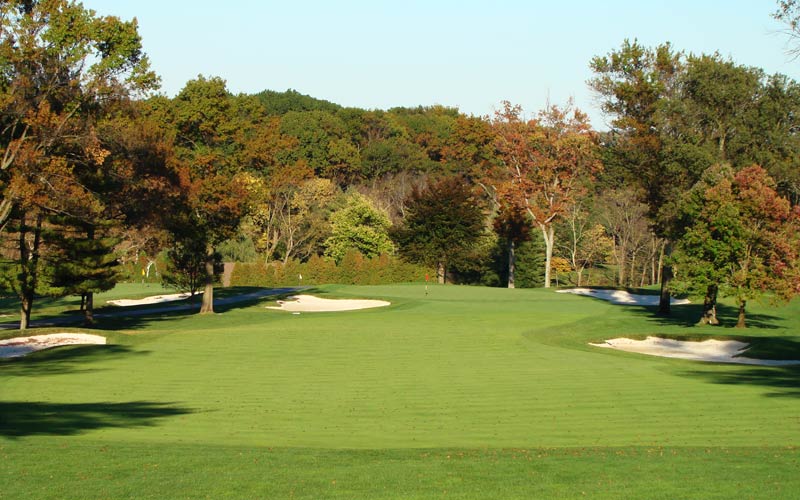
Though the playing corridor is straight, look at the interesting angles of play, thanks to the tree removal program and the fairway mowing lines now being correct. For example, the right fairway bunker is distinctly in play for left hole locations.
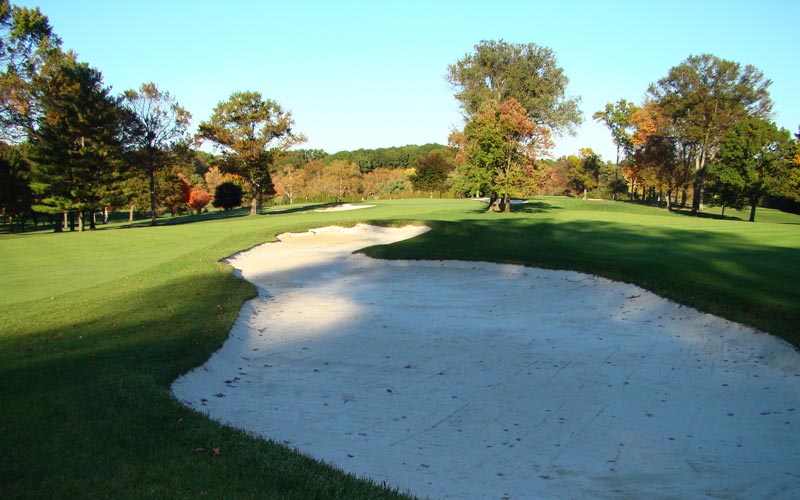
The aforementioned right fairway bunker is actually fifty-one yards in length, though it doesn’t look it from either the first tee or the ninth tee whose fairway runs parallel in the other direction.
Second hole, 375 yards; Lancaster is a fascinating course for William Flynn students to study as there is so much of him throughout the design. After all, he worked here for twenty-six years, so there ought to be! Having said that, there are three notable exceptions to this being a pure William Flynn design and the first occurs here at the second where then Green Chairman H.H. Haverstick (a superb amateur golfer) moved William Flynn‘s green location some forty yards to the left. In William Flynn‘s day, the second played as a straightaway par four. In 1966, the club displayed good sense in pursuing Haverstick’s idea of shifting the green away from a cluster of mature trees to the more open site high along the river bank. In doing so, the hole now doglegs left around a deep hollow with its green location taking maximum advantage of this dramatic spot on the property. Also, the green has ever since enjoyed better sunlight and circulation (and therefore better turf) than in William Flynn‘s location. Today, though long views are afforded from the green over the course and out to the countryside, such views would be all the more breathtaking if the club removed more of the oak and scrub trees along the river bank. A clean backdrop to this horizon green would surely help make this one of the more spectacular spots in the golf rich state of Pennsylvania.
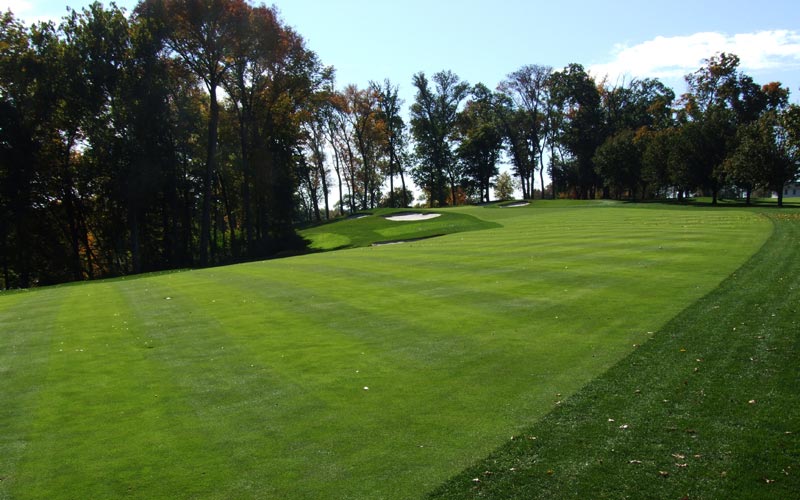
The second fairway now bends left around a deep hollow to an excellent green site benched into the hillside. Perhaps some trees should be felled behind the distant green?
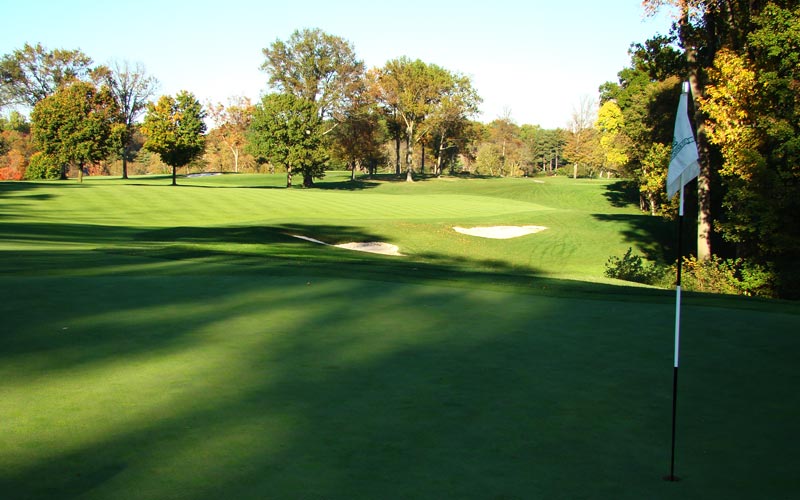
This view from behind the flag highlights one of the perils of the second: the fairway’s sharp right to left cant makes it the single hardest fairway on the course to consistently hit.
Third hole, 400 yards; Some of Ron Forse Design’s very best work occurred here, making this perhaps the hole that has most improved in the past five years. Jim Nagle describes its transformation as such, ‘The 3rd hole was long known as a medium length par 4 with a very narrow tree lined fairway. As a hole, there was little interest as you just hit your drive and hoped it a) landed in the fairway and b) was far enough to get to the upper slope. In July of 2005, Rick Gibson, the club’s golf professional, brought forth a small treasure – a late 1930’s plan from William Flynn for this very hole! The bunkering plan was never implemented but it revealed the intended strategies designed by William Flynn which included three bunkers in a diagonal echelon along the right that were nestled into a natural upslope. Two bunkers were intended to the left parallel to the line-of-play eliminating a bail-out area and providing ball containment. Our plan carried out the three bunkers right and one bunker left and numerous trees were removed. We opted to not place two bunkers left as there is plenty of challenge for shorter hitting members. Those not able to reach the upper level of the fairway have a daunting uphill shot to a green surrounded by large deep bunkers. It was a good thing the 2nd bunker was not added to the left because the amount of rock encountered in constructing the one left bunker was excessive. The fairway had to be greatly expanded to the right creating a reward landing area for those negotiating the right bunkers. The tree removals, bunker additions and a new tee have taken a hole described as “not interesting” to one involving risk, strategy and great interest. One can challenge the right side bunkers and be rewarded with a shorter slightly elevated (allowing greater visibility of the green) approach shot. Golfers playing away from the right side must think about the one bunker but also do not see as much of the green as those to the right. The greenside bunkers had been masterfully restored by Gil Hanse in the late 90’s leaving very little work to be done.’
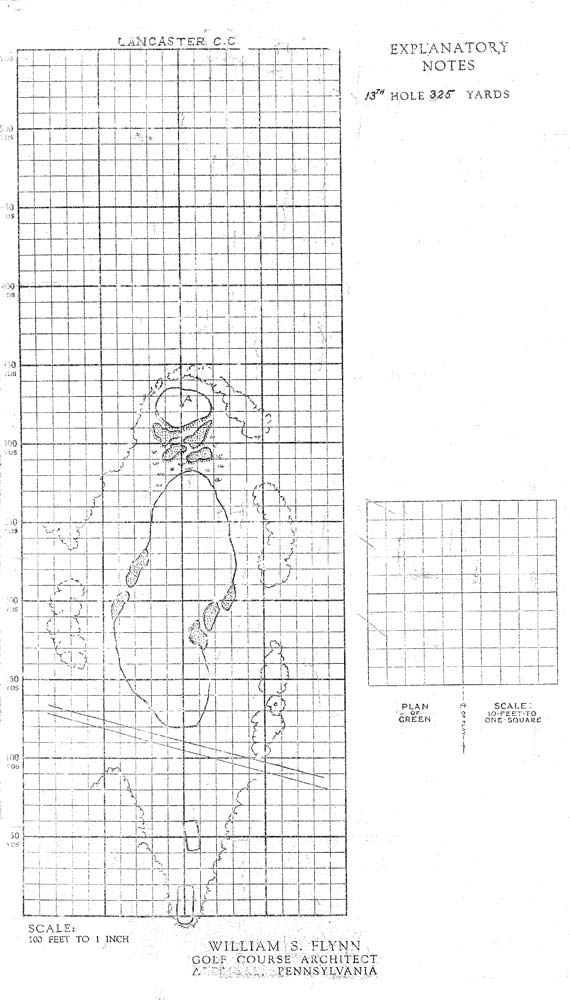
The uncovering of Flynn’s hole design by Gibson allowed Forse Design to turn…
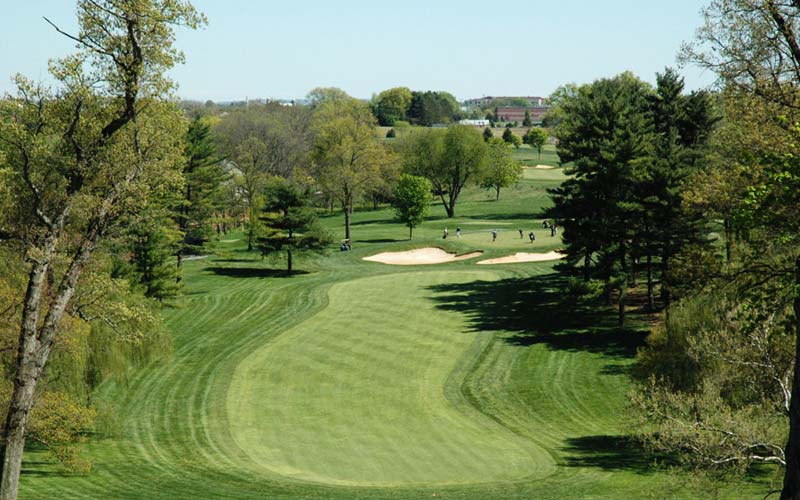
…the third hole as seen above in 2004 with its lack of strategic interest off the tee into…
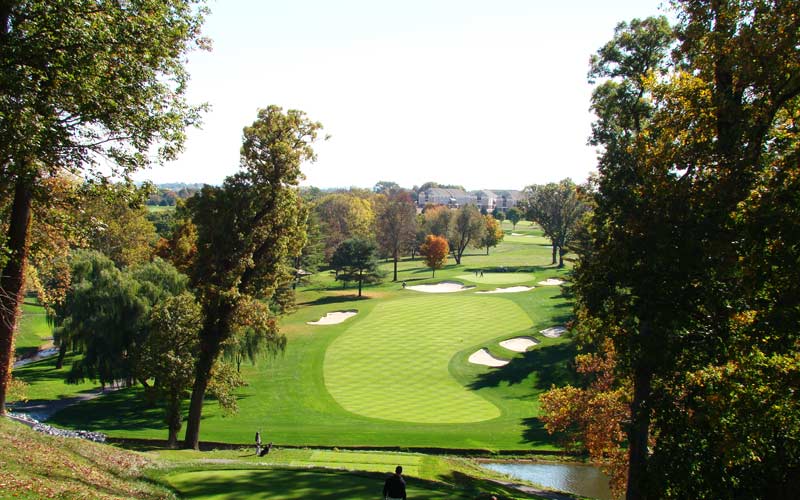
…this far more engaging and dynamic hole in 2008.

This view in the fairway back up to the third tee captures the hole’s one hundred foot plunge in elevation.
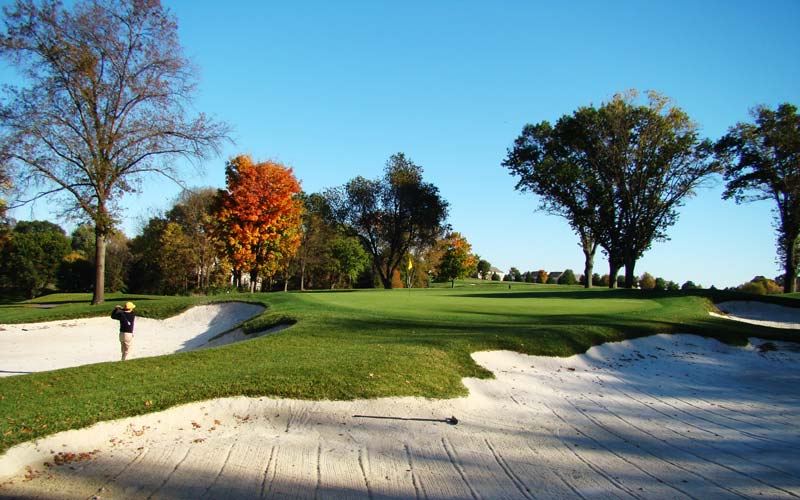
The right to left pitch of the tightly defended third green needs to be considered on one’s approach.
Fourth hole, 315/395 yards; For decades, this hole has been viewed as one of the great short par fours in the game. Though a new tee added in 2000 pushes it to nearly 400 yards, this sadly is what is required to make the fourth play as a three wood/pitch hole as it did in William Flynn‘s day of hickory golf clubs. Like he did at the sixth hole at the Cascades at the Homestead in the Virginia mountains, William Flynn routed the fairway to the left of the water hazard (a tributary of the Conestoga called Stauffer’s Run) and placed the green on its other (i.e. right) side. His real genius at both holes occurs at the greens which are both long but narrow. The advantage is squarely gained by the golfer who hugs the water hazard, thus enjoying an easier pitch down the length of the green. As you play cautiously away from the hazard, the approach shot becomes both longer and from a progressively worse angle.

As seen from the tee, the fourth fairway plays straight-ahead though the green is to the right on the other side of the creek in the shadows.
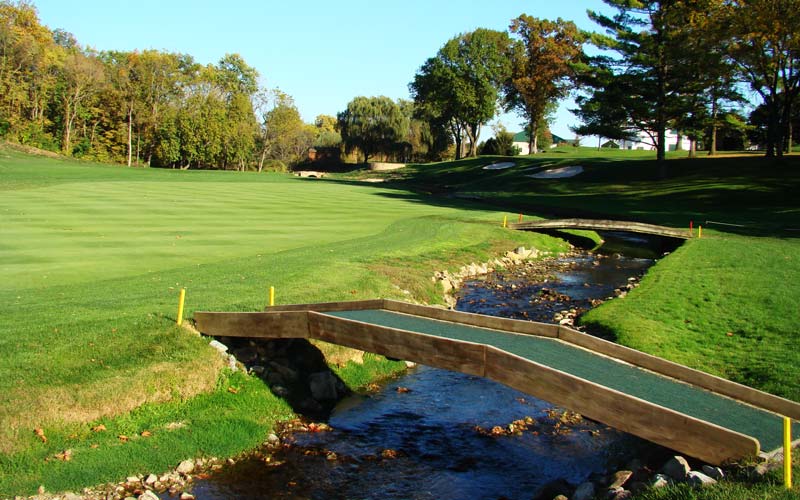
From fairway level, the golfer sees the elevated green on the far side of Stauffer’s Run.
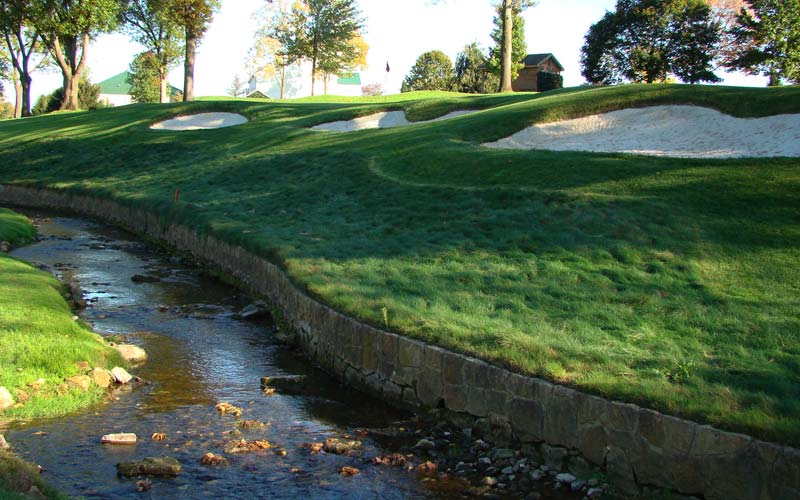
The elevated fourth green makes for an elusive target. It is long (i.e. it follows the creek) but narrow from side to side. Thus, only those golfers that play near the creek off the tee are offered much of a target.
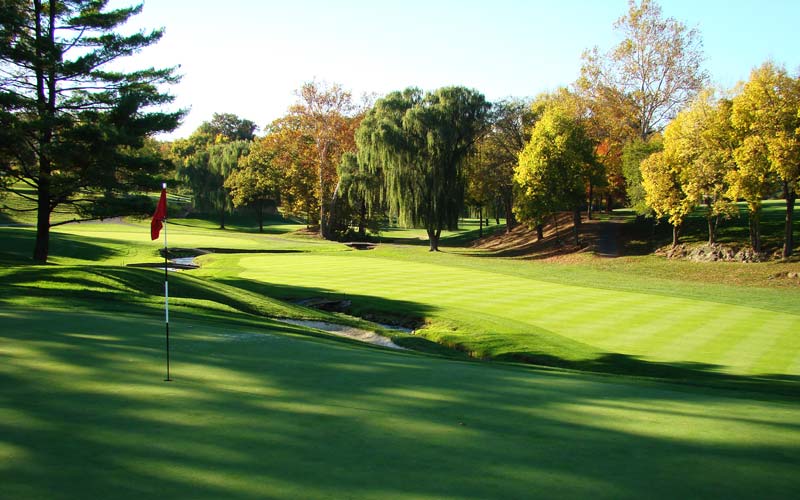
The spine of the green points straight back to Flynn’s 315 yard tee. Given today’s technology, more than one club golfer tries to take the heroic shortcut and drive the green.
Fifth hole, 390 yards; Golf design at the highest level makes golfers think. If everything is laid out cleanly, then the golfer merely has to execute shots as if on a driving range. Standing on the tee, the golfer is aware that the green is left past a ridge and the inclination is to be lured into taking a short cut in that general direction. Once past the ridge, the land does nothing but fall away toward the tree lined creek. Position ‘a’ off the tee is actually on the outside of this dogleg left. Also, it is worth noting that this is the one time on the course where William Flynn routed a par four or par five from high ground to high ground from the tee. Though this is a typical practice of many Golden Age architects, the golfer finds out in full force on the back nine that William Flynn had no compunction in placing his fairways well lower off the tee, leaving taxing uphill approach shots.

Though the hole swings left, the golfer does well to force himself to play his tee ball just right of the crosswalk.
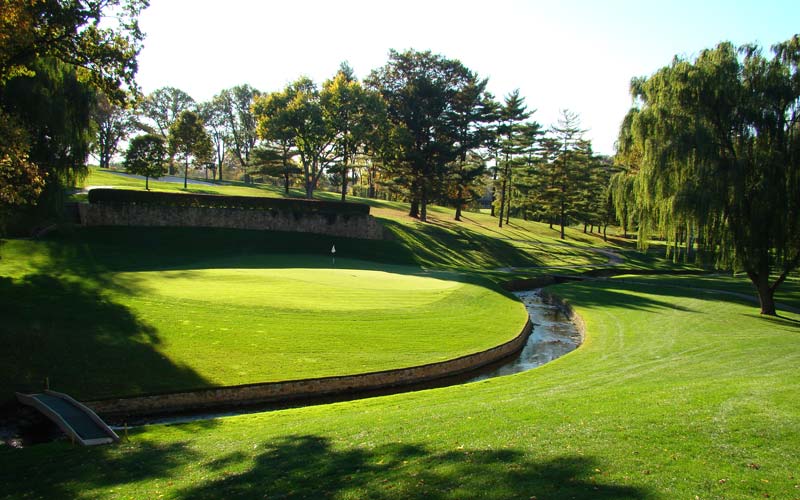
The approach to the fifth is a rare downhill one to a green on the far side of the tributary. Given Flynn’s clever use of the ridge off the tee and the natural water hazard, no bunkers were required.
Sixth hole, 180 yards; The principle is simple yet effective: give the golfer one main hazard with which to contend and then provide him plenty of room on the opposite side so he can steer clear of it. Here the ten foot wide tributary snakes its way between the tee and the green before hugging the green’s left side. At some point in the golfer’s downswing (or is it backswing?), he makes the determination not to go left and consequently, some gosh awful swings send tee balls well right of the green. At one point, a bunker was mistakenly added after William Flynn‘s death front right but that only served to help the golfer focus on hitting the green. Once again, it is just grass and golfers are quick to seek this area as their bail-out. From there, an up and down is unlikely as William Flynn, of course, made sure that the green slopes from right to left toward the creek. Congratulations are due to William Flynn for devising a modest length downhiller that is simple in appearance yet that elicits more fours than it should.
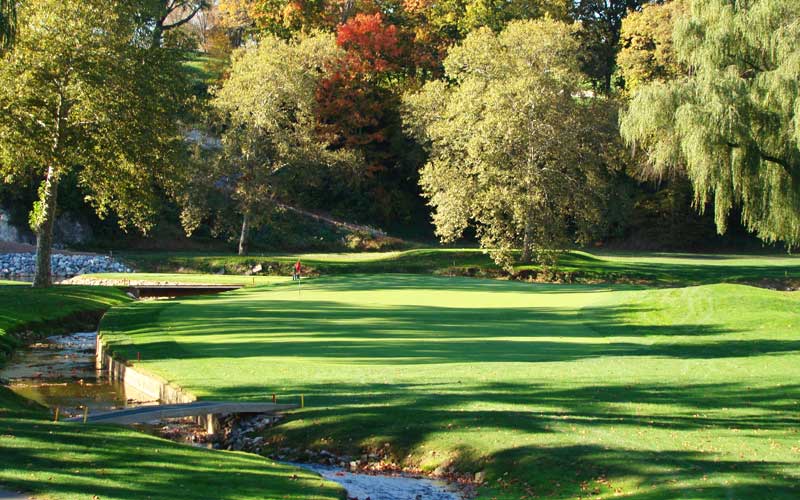
With water left and grass right, the golfer knows where not to go. The large sycamore tree to the left of the green actually steers players away from the creek. Hence, why it isn’t removed is a mystery to the author.
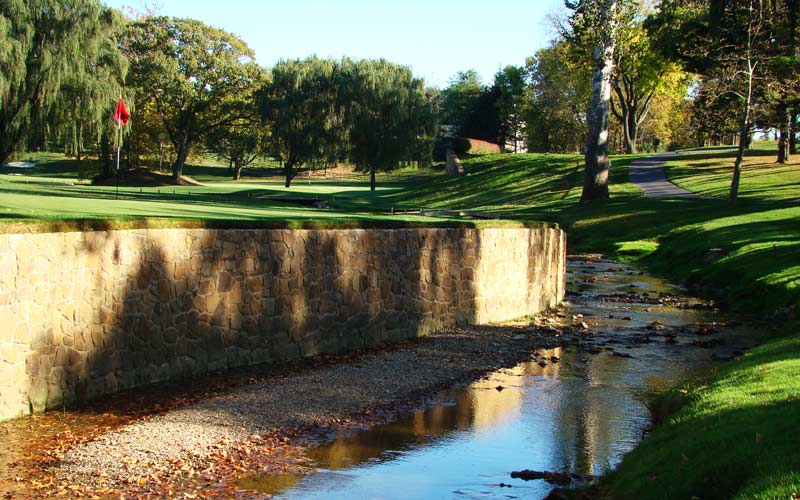
As seen from behind the green, any shot pulled left of the green meets a watery fate. That one fact creates all sorts of bizarre swings on the tee as golfers steer to the right.
Seventh hole, 530 yards; A tale of two tees, with one set providing a classic diagonal carry across the Conestoga River while the other plays from up high on the river bank on the other side of the river. Though distinctly different, both tees are compelling and offer their own sense of drama. Further ahead, a water hazard defends this reachable par five green. Though notable examples of William Flynn using a water hazard greenside at a par five include the penultimate holes at Cherry Hills and the Cascades, he did not build this one. An aerial from 1947 (i.e. two years after his death) shows William Flynn’s green to be at and slightly right of where the pond now is. When exactly the club added the water feature and moved the green is unclear but it is likely tied to the addition of the pump house near the area that William Flynn‘s green once occupied.
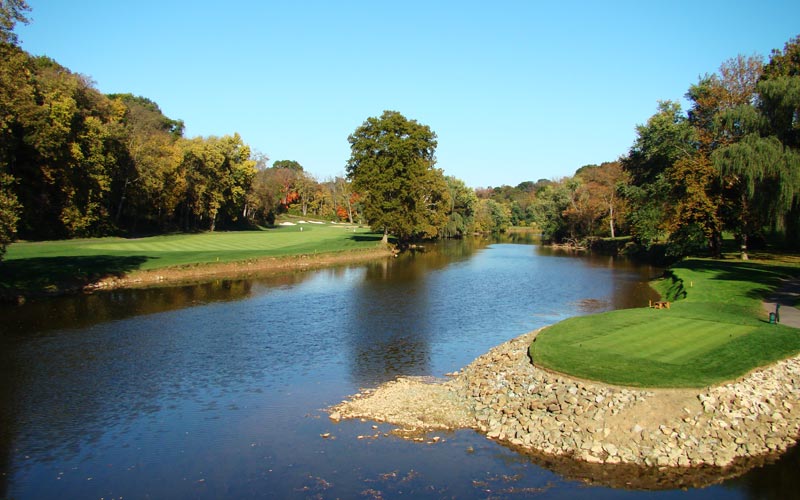
It’s exhilarating moments like this diagonal carry off the seventh tee that give Lancaster a flavor all its own. Nonetheless, man bowing to Mother Nature is seen in two ways. First, the rock around the seventh tee is there to provide stability to the tee box when the Conestoga River floods. Second, the mature trees along the far side are left to provide stability to the bank.
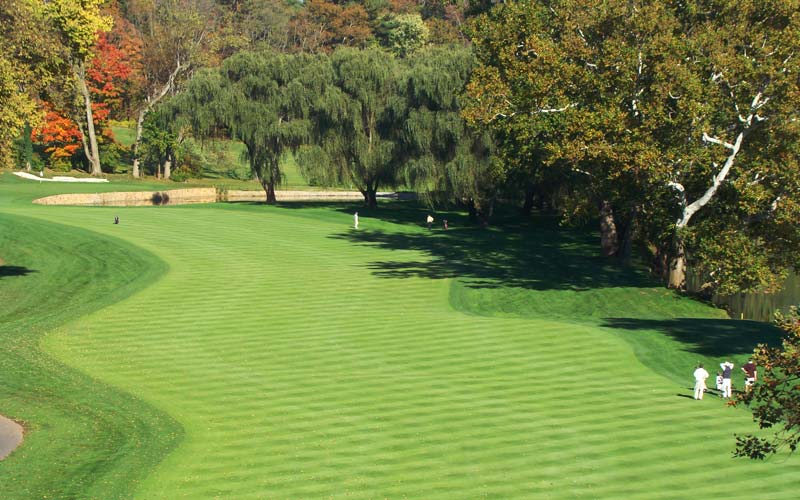
In quite a contrast from the right back markers, here is the view from Flynn’s elevated tee markers on the other side of the Conestoga River. From this set, the golfer isn’t afforded the luxury of aiming away from the river. Consequently, more balls actually find the river from this elevated tee than from the right set despite the forced carry from the right.
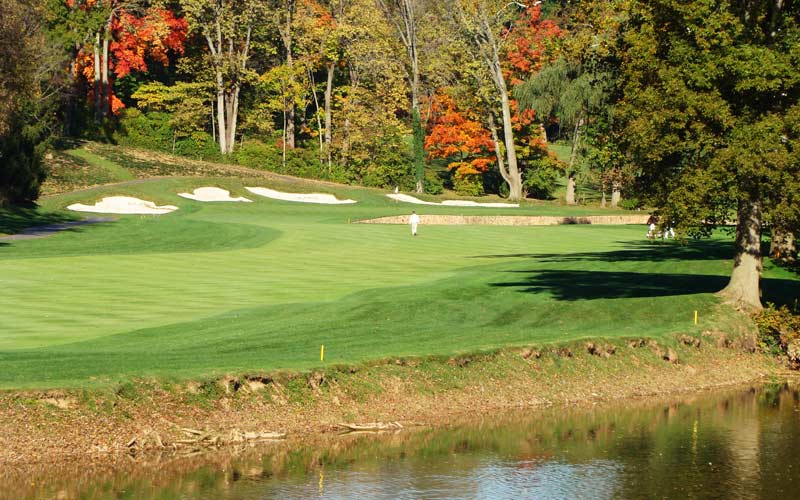
The attractive view up the seventh fairway from the back markers highlights a rarity at Lancaster: a flat fairway that yields plenty of level stances. It is nice that such a stance is afforded here as it helps goad the golfer into having a go for the green in two.
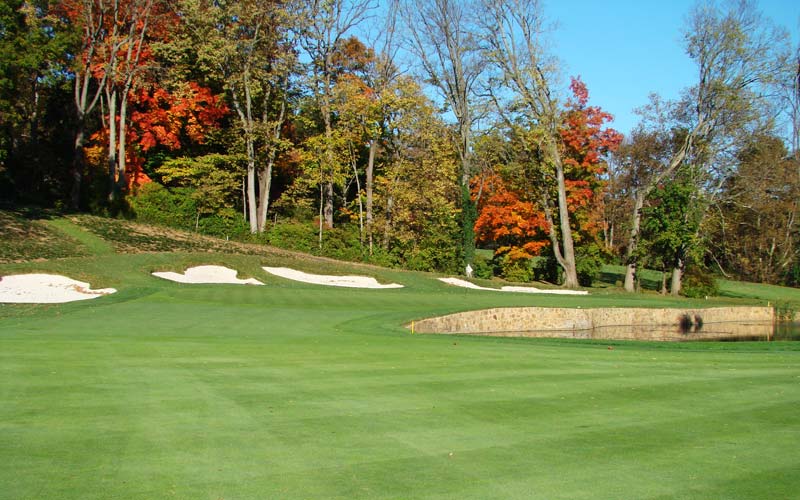
Dare the tiger golfer thread his second shot past the pond and onto the angled seventh green?
Eighth hole, 200 yards; The holes at Lancaster have an ebb and flow all their own, which is the truest sign that the architect followed nature’s lead. Think of the six holes that you have just played and you will realize that length has little to do with their challenge. Perhaps the tiger golfer had an eagle putt at the last or maybe he got one of his short irons close for a birdie or two. He wants to hope so because the golfer now enters into a demanding five hole stretch. Here at the eighth, the course’s finest one shotter may also be the hardest hole on the course to par, season in, season out.
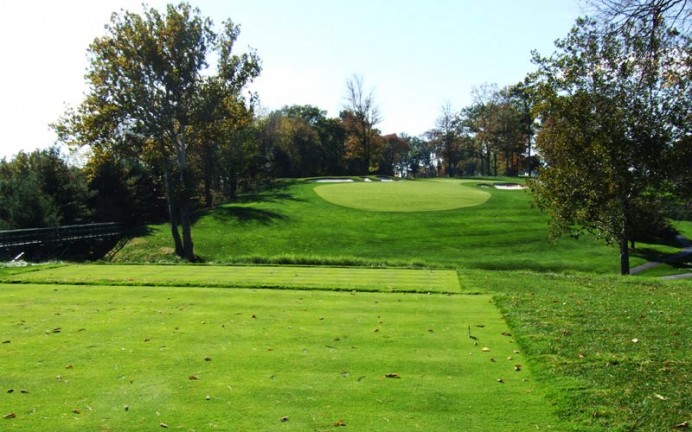
Where there are bridges, there is interesting land and the bridge as seen to the left is the second one that the golfer crosses on this nine holes. As opposed to the first bridge which takes him over and then back across the Conestoga River, this one takes the golfer across a ravine.
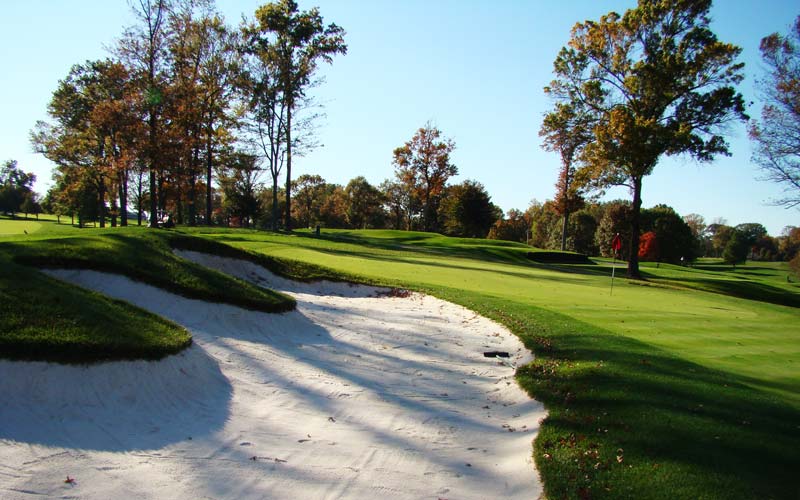
This long bunker only touches the front edge of the green but extends thirty yards back toward the tee on a diagonal angle, framing the landing area in front of the green.
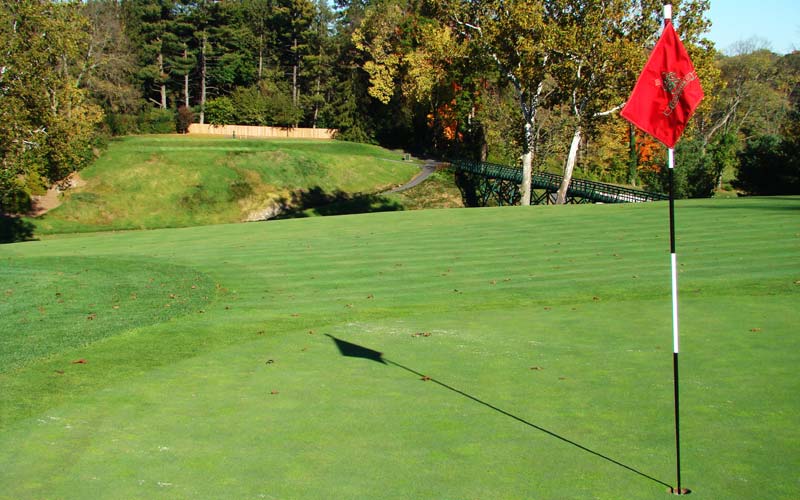
Importantly for a hole of this length, the eighth green is open in front, allowing for all sorts of shots to be played into it. Green Keeper Bidlespacher does a fantastic job of making sure that this area before the green stays firm; otherwise, the hole wouldn’t play properly.
Tenth hole, 480 yards; After playing across a ravine at the eighth, the golfer leaves the river valley and the most unique landforms. The second nine is played in a pastoral setting of rolling hills for which the Pennsylvania Dutch is famous. Nonetheless, it is important that the second nine get off to a fast start or a tinge of regret in leaving the river valley could turn into something more. Fortunately, Flynn produced one of his all-time best par fours and the golfer never looks back. Appreciating Flynn’s background as the Green Keeper at Merion Golf Club from 1913 to 1918, Forse notes more than just a passing resemblance between this mighty hole and the home hole on the East Course at Merion. In addition, the double bend in the fairway (i.e. the fairway bends right off the tee then proceeds straight before bending right again toward the green) fascinates Forse. Without doubt, Flynn had few peers in draping holes across the landscape and in creating interesting playing angles.
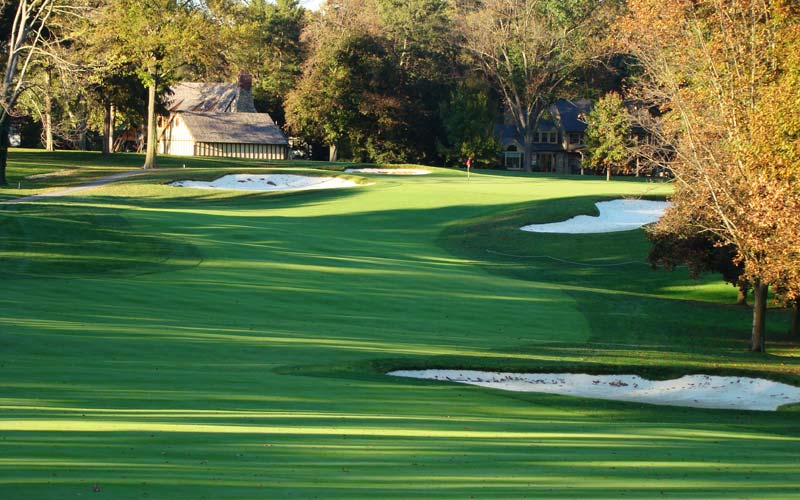
The great tenth at Lancaster enjoys playing similarities with the eighteenth at Merion, namely the requirement of hitting a long approach from a downhill stance to an uphill green.
Eleventh hole, 475 yards; The thing about a Flynn design is how effortless it appears. His holes, and thus his courses, never fight the land and are based in what nature gave him. Thus, they possess a timeless quality. Take the eleventh for instance. From an elevated tee, Flynn drops the golfer into a valley from where the golfer then plays his approach to the uphill green. The only significant dirt that was moved occurs at the tee and then the green where Flynn benched the green complex into the hill. In particular, he had to prop up the green’s left side to allow it to function properly. As it is, putts still break over a dozen (!) feet from certain locations on the green.
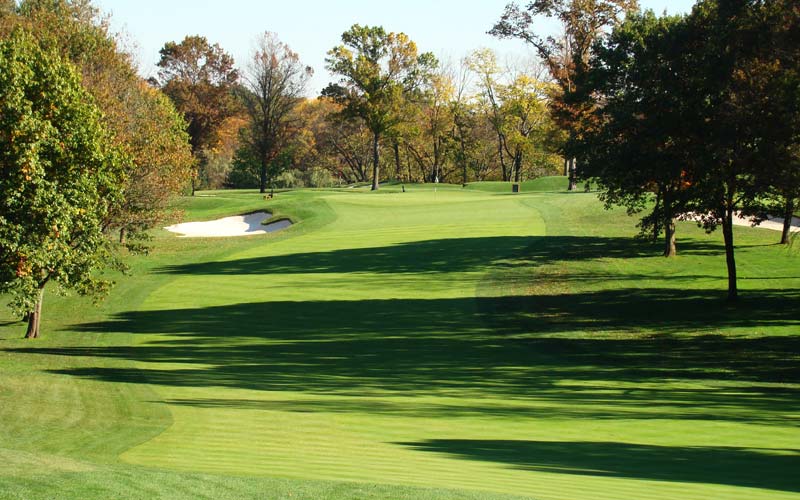
There is nothing forced about the eleventh. Nonetheless, it possesses fine playing characteristics just by how Flynn benched the green site into/on top of the far hill.
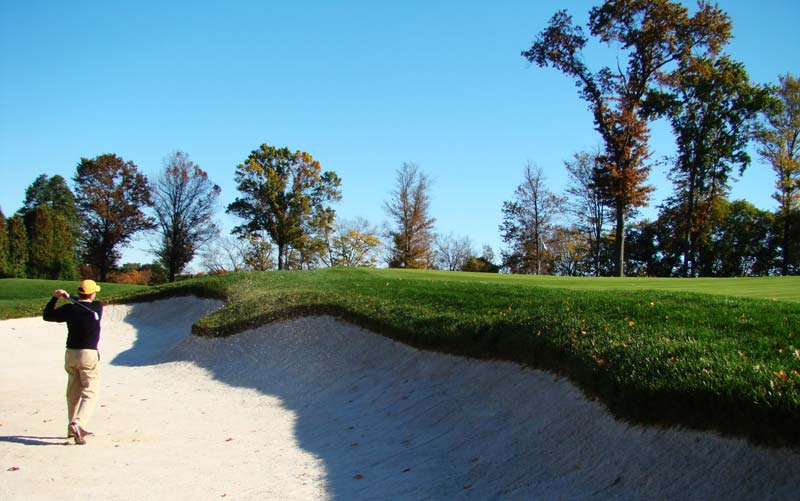
Building up the left of the green pad made it easy for Flynn to achieve this kind of bunker depth at its left front. Nothing contrived – just good golf.

This view from behind the eleventh green hints at the terrors in this right to left canted putting surface.
Twelfth hole, 180 yards; The one shot eighth parallels this hole in the other direction yet you couldn’t have two more diverse par threes. As opposed to the former which plays from one high bank across a valley to a long green on the far side, Flynn drops the golfer fifty feet down to the valley floor with this one shotter. Along with the fourth, this green represents the shallowest target on the course with a creek and five bunkers defining the tight target. The rub is the wind as there is no place on the elevated tee to hide from it. Some members don’t particularly mind should the wind grab their opponent’s tee ball near its apex and deposit it unceremoniously into the fronting water hazard.
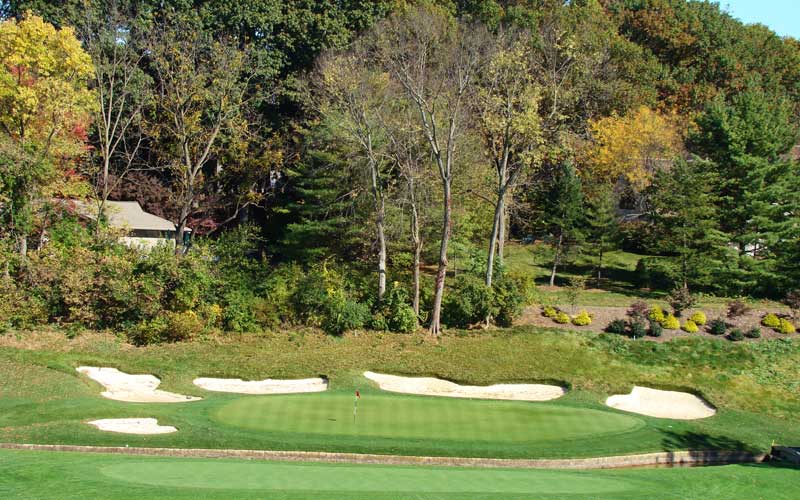
At just under twenty yards in depth, the twelfth green offers little room for error.
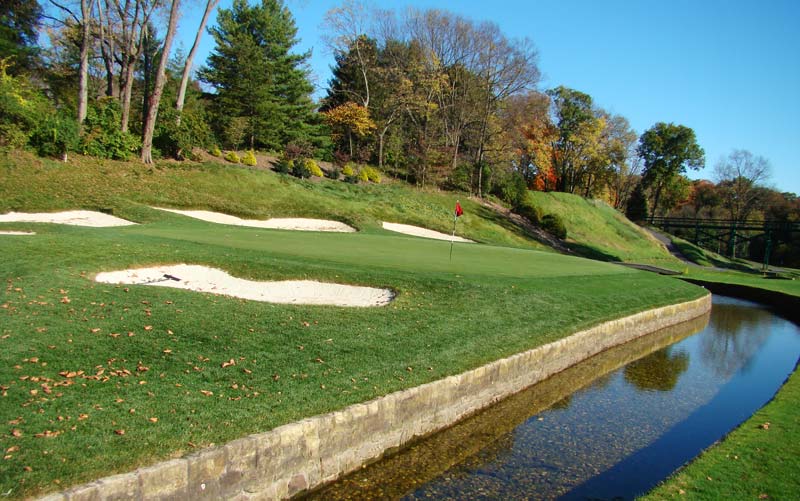
The creek is such that even if you go in it, you can retrive your ball. Losing golf balls on a Flynn course is a rarity.
Thirteenth hole, 515 yards; Ala Flynn’s masterpiece at Shinnecock Hills as well as Huntingdon Valley A/B, Pine Valley and Merion, Lancaster features only two par fives. This one adds much to the course, not so much because it is difficult but rather for the other reason: as a 4 1/2 par hole, it offers hope to all golfers in the middle of a tough stretch. This is a good thing as a certain sense of give and take by the architect is integral in most Golden Age designs. Obviously, it would be easy to move this green sixty yards forward and make it a tough two shotter to an uphill green. However, this nine already has plenty of those! The sixty yard pitch that many are left with on this double dogleg hole requires the most feel/finesse of any single shot on the back nine.

Any tee ball that doesn’t find the fairway makes it problematic to reach the top plateau with one’s second. When the hole is properly played, the golfer should be left with a mere pitch for a potential (much needed!) birdie.
Fourteenth hole, 405 yards; Ron Forse has always been a fan of this hole and he is particularly pleased with how their work turned out here. He writes,
Always a solid par 4 (like so many at Lancaster) the uphill 14th possessed stiff shot requirements but seemed to lack something. When we planned improvements in 2005, the dogleg right 2-shotter reminded us of the 14th at Shinnecock Hills with its similar setting and routing. Shinnecock’s 14th is regarded as the best par 4 in the Met area. Lancaster’s 14th had two fairway bunkers, one right and one left. It cried out for a third feature, which would be situated on the left side, just beyond the turn. The three fairway bunker complex, arranged in a triangle and placed at distinct differences from the tee, is a common Flynn motif. And a quick review of Mr. Flynn’s 1920 plan for the course happily revealed just such a fairway bunker scheme. Adding the third bunker made one of the greatest changes to the course. Instead of a thought process of simply hitting the middle of the fairway or bombing it over the right-side corner bunker, golfers must now consider every shot possibility at the tee. Whereas one could hit into the left rough with a driver to avoid sand right, the newly restored bunker now makes you consider a 3-wood off the tee. But the hole is long and demanding enough that you want to hit driver and get past the trouble right, bringing the left side peril into play. One can draw or fade over the right sand hazard and find great reward, if well struck. And if you choose to avoid the far hazards, the shorter left side bunker is prominently in-view. This safer option however, puts a VERY long approach club in hand for an uphill shot to a severely back-to-front sloped green. From this distance an exceptional shot is needed to avoid ending up in 3-putt range or having a tricky chip shot. Flynn’s original asymmetrically arranged flanking greenside bunkers have been retained and restored/improved. The end result of the restoration of the 14th is a nice balance of shot values and strategic options and it reveals Flynn’s genius for infusing complexity into a hole through superb routing and his tastefully restrained placement of hazards.
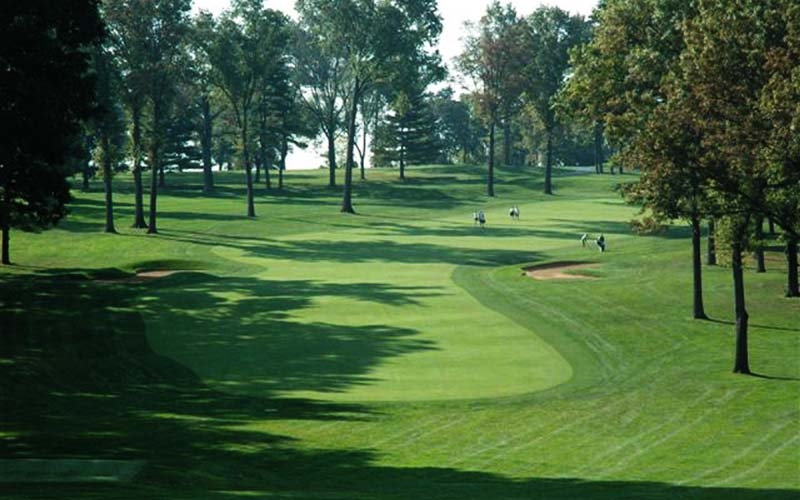
In 2004, the golfer could easily avoid the shallow inside right bunker by driving long left. Now…
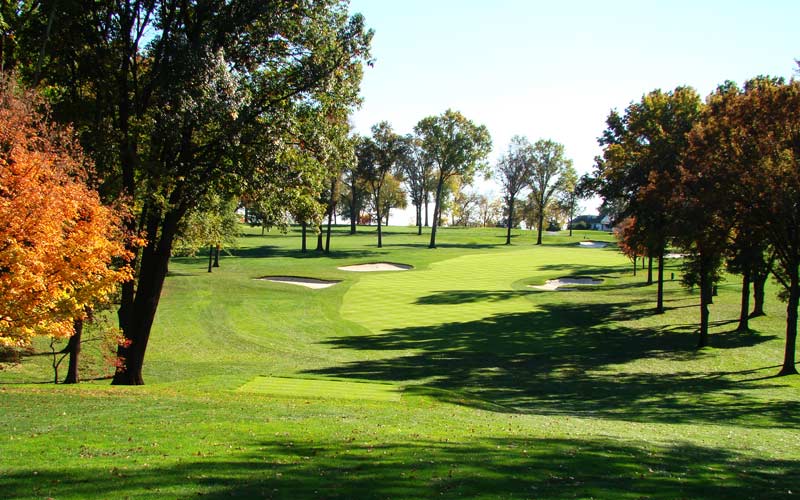
… with the return of the third bunker and by increasing the depth of the fairway bunkers, the golfer has to carefully select the best option off the tee on a given day.
Fifteenth hole, 440 yards; During his tearful acceptance speech after winning the 1998 United States Open at the Olympic Club in San Francisco, Lee Janzen spoke about how exhausting the course was with its requirements to move the ball left to right and right to left off the tee in order to hold the sloping fairways. Though the game at the elite level has changed since then to one of power, talented old-guard golfers still appreciate the nuances of playing such shots. Similar to the Olympic Club in this one respect, the golfer at Lancaster who can work the ball either way has a marked advantage over someone less talented. Take here where Flynn bent the fairway around to the right along the side slope of a broad hill. Though the fairway swings right, the land falls away to the left; thus, only a fade will hold this firm running fairway. In addition, one is virtually guaranteed on one’s approach that his ball will be above his feet (or below his feet if he is a left hander). Trying to control a ball into the right to left tilted green from such a stance will test the very best as anything past a slight draw is doomed to find the far left edge of the green. This hole is another example whereby Forse Design is working with the club board to return more of Flynn’s handiwork to the course. Aerials eight years into the course’s history show no bunkers on the inside of the dogleg right but Flynn built two enormous bunkers there sometime during the 1930s. These large bunkers are an example of Flynn continuing to refine the course well into its existence. Today’s smaller bunkers are a poor substitute and the return of Flynn’s heroic size bunkers would be a welcome event.
Sixteenth hole, 355 yards; The last two par fours swing right so it comes as no surprise to step on this tee and see this fairway moving left. What is a surprise is that this oft photographed hole was not built by Flynn. Its general configuration of bending sharply left around a nest of bunkers to a green reminds many of Flynn’s first hole at Philadelphia Country Club. In fact, Forse Design greatly expanded the breadth and scale of the bunkers here at the sixteenth at Lancaster in a similar manner to how they restored Flynn’s bunkers at the first at Philadelphia Country Club in 2000. Though some no longer exist, this type hole prevaded many of Flynn’s best designs including Huntingdon Valley, the North and South courses at Boca Raton, Indian Creek, The Country Club and others. Architecture students also see playing characteristics akin to Flynn’s tenth hole at Merion as well as the twelfth at Pine Valley. Hence, it is fair to assume/conclude that Flynn built it. Alas, history tells us otherwise and as at the second hole, Mr. Haverstick in 1966 again suggested moving Flynn’s green location some sixty yards to the left and down into today’s natural amphitheater. Initially, Flynn had this hole play straightaway from today’s tee to a green located on the far embankment. As at the second, the Gordons carried out the wishes of the club and built the sixteenth green and bunkers along with help from long time Green Keeper Bill Mellon. Even Wayne Morrison agrees that the second and sixteenth holes of today are huge improvements over Flynn’s designs, so give the club credit for knowing when to embrace selective change (the pond at the seventh is a third and final such example).
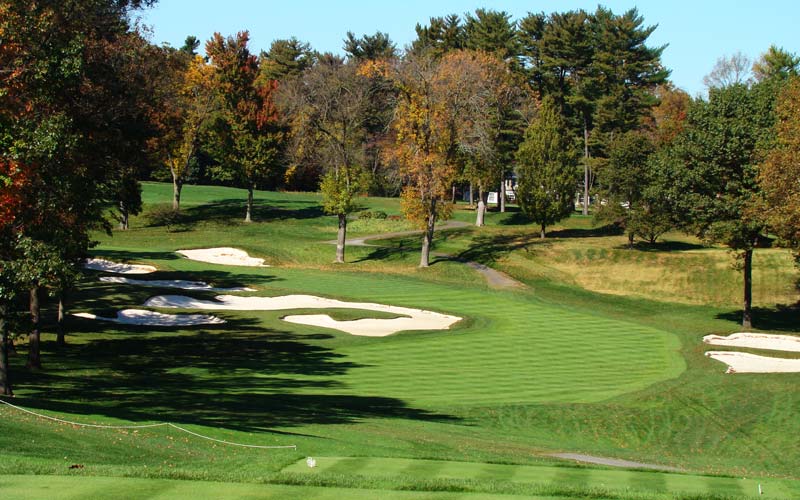
Flynn’s green was originally just right of the cart path snaking up the far hill. Haverstick with help from the Gordons created today’s dogleg left with its interesting array of bunkers.
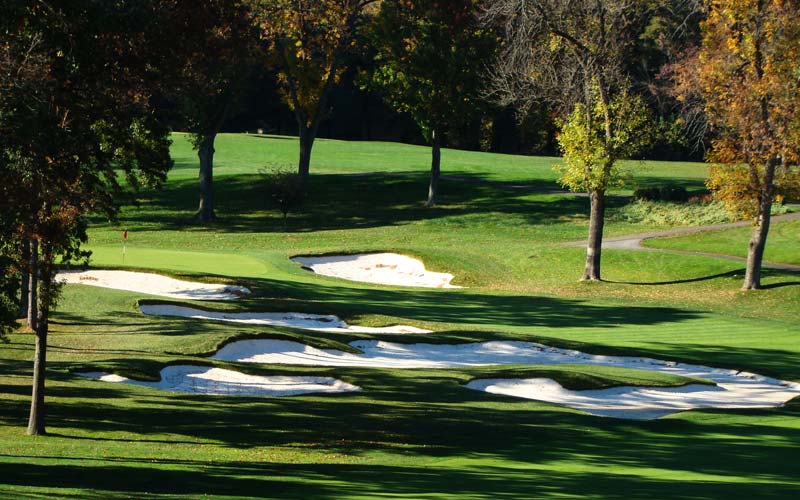
The big scale bunkers as restored by Forse are in keeping with the rest of the course and lend the hole a comparable sense of drama to the short par fours on the front that possess water features. A tee ball knocked down the hill some 235 yards leaves …
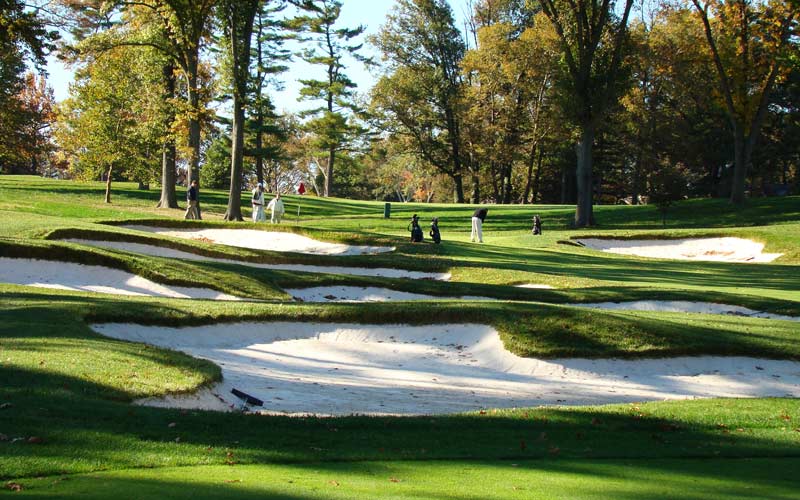
… a 120 yard pitch from here. Appreciating that the putting surface reflects its natural setting, the golfer is keen for his approach to stay below the hole on this back to front sloping green.
Seventeenth hole, 180 yards; The merits of this hole are in some ways better appreciated for what it isn’t rather than for what it is. What it is is a par three over level ground to a green with a typical Flynn front right to back left angle – think the penultimate hole at Shinnecock Hill’s as Flynn’s most famous high profile example. What it isn’t is what one finds far too frequently on modern courses – a hole contrived for excitement, generally with water. Such a hole would be grotesquely out of place at Lancaster. To the credit of the club as a steward, they have resisted for six plus decades after Flynn’s death into making this something that wouldn’t reflect its natural properties.
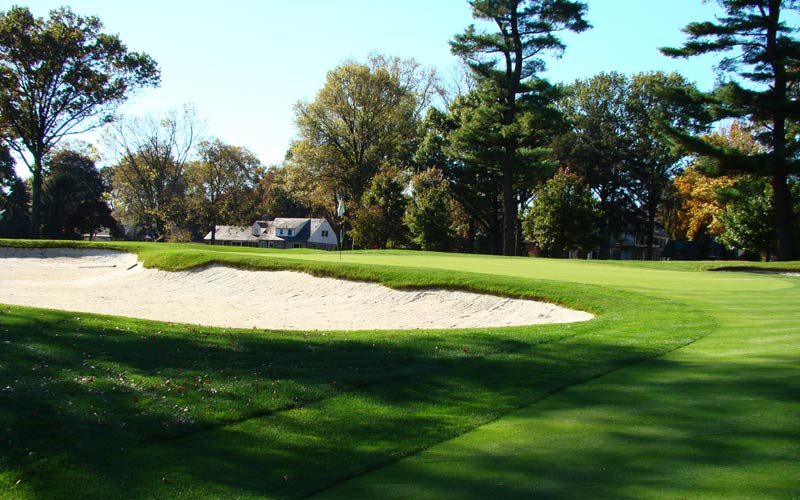
The seventeenth comes as somewhat of a surprise as the golfer has become accustomed to playing holes that frequently have thirty plus feet of elevation change. Set across a flat field, Flynn gave it good golfing values with its angled green sandwiched between the big fronting left bunker and a smaller right one. Though not dramatic, this one shotter bleeds shots from golfers.
Eighteenth hole, 470 yards; Eight of Lancaster’s twelve par four holes feature a significantly uphill approach shot, which means a couple of things. First, the course plays longer than its yardage suggests (and at 6,850 yards, the course is plenty long). Second, elevated greens on Golden Age courses typically feature fierce interior contours and/or pitch and such is the case at Lancaster. As at Rolling Green, Flynn may have saved the best for last with this nearly 10,000 square foot green that drops seven and half feet (!) from back to front over its forty-three yards. This hole will finally get its fair share of recognition and accolades if Lancaster hosts the United States Women Open championship in 2015 as is rumored.
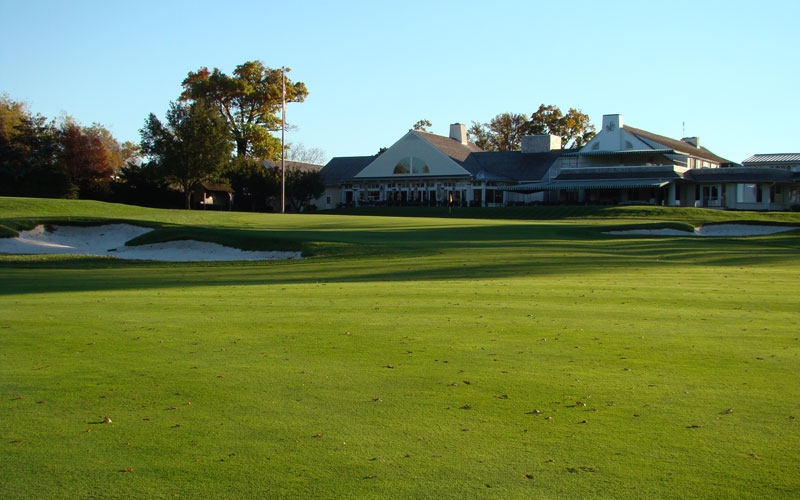
What a sight and what a final approach shot to have to execute, especially as often times it may be from 200 hundred plus yards away.
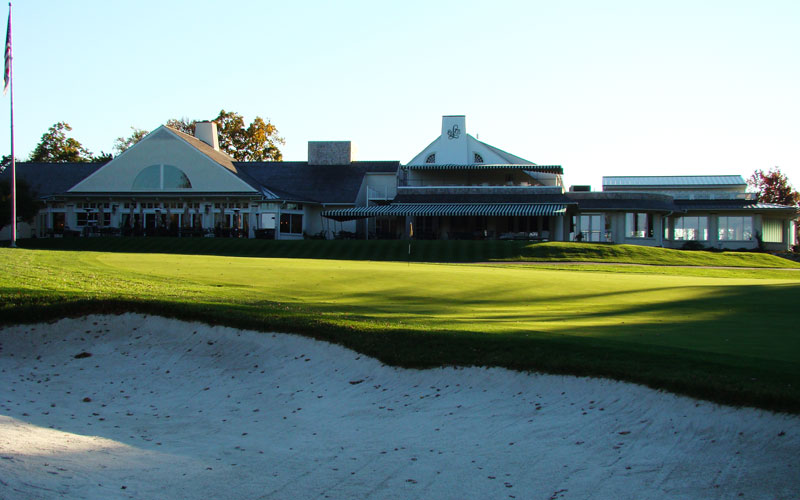
With members watching the proceedings, the sharply sloped putting surface ruthlessly exposes frayed nerves.
Lancaster holds true to Flynn’s own dictum that, ‘The principal consideration of the architect is to design his course in such a way as to hold the interest of the player from the first tee to the last green and to present the problems of the various holes in such a way that they register in the player’s mind as he stands on the tee or on the fairway for the shot to the green.’ While Lancaster has no overt weakness, its ultimate strength lies in the amazing variety of its twelve par fours. From the classic drive and pitch holes on the front to the big brawny par fours headlined by the tenth and eighteenth on the back, no one could ever hope to be a member of a course that possesses greater diversity among its two shotters.
Ben Crenshaw toured Lancaster for the first time in the fall of 2008 and summed up its attributes when he said: ‘I had heard about Lancaster for many years and had always wanted to see it as it is known not just in the GAP but nationally. With the lay of the land and Flynn’s routing, the tee shots set up differently from each other and are demanding. You have to get the right tee shot off in order to set-up the proper approach shot because of the way Flynn built the slopes in front of and within the greens. Overall, its shot values are demanding but the course remains a delight to play.’
Morrison also puts it well when he writes, ‘Consider the timeline of changes at Lancaster and one grasps the impact of improved players and technology on the sport and Flynn’s design response to these factors. Very few courses offer the variety of enjoyable difficulty and as fine a collection of long but interesting par fours. All who golf at Lancaster Country Club know that these old grounds for golf, though so often changed, remain one of America’s great courses.’
Thanks to the work by Forse Design, Lancaster is again a standout design, not only among Flynn’s own work but also other Golden Age designs and modern courses as well. Why is this? The answer is both time and continuity. Flynn was provided the luxury rarely afforded architects today of being able to make adjustments/improvements to the course over a substantial period of time. Most significantly, this included the purchase of the land east of the Conestoga twenty years into the life of Flynn’s course and the resulting exciting new holes. However, tweaking by Flynn to the bunkers and the greens, though less dramatic, also led the course from the age of hickory golf clubs into the one of steel. To the advantage of all parties concerned, Flynn’s interaction was primarily with Roy Eshelman and the benefits of the working bond formed between these two can once again be seen in the dirt today.
When their partnership came to an end with Flynn’s death in 1945, the transition seamlessly fell to William Gordon, a former partner of Flynn’s, and then his son David. Now, Forse Design is doing what it does best: meticulous research that allows them to help guide clubs to recapture the best playing features of their Golden Age courses, all while making it look like Forse Design was never there. The end result is a design that strikes the perfect balance between fun and challenge in a splendid environment free from outside disturbances.
The End

